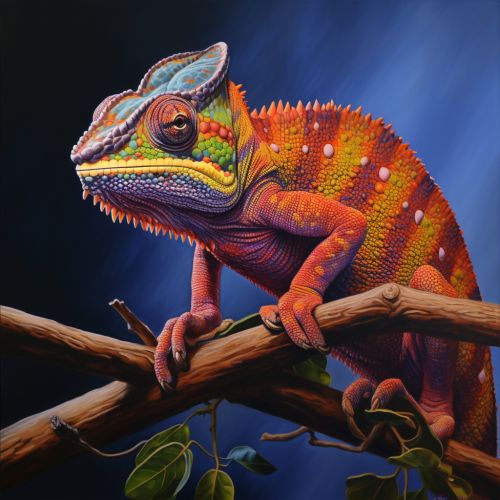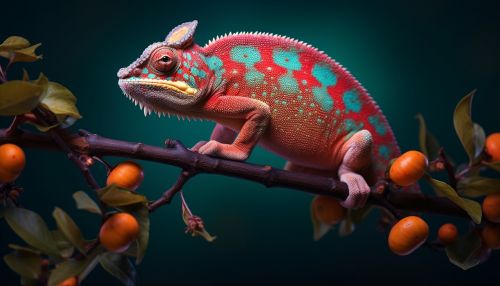Chameleon
Introduction
The Chameleon is a distinctive and highly specialized clade of Old World lizards with over 202 species described. These species come in a range of colors, and many species have the ability to change their skin color and pattern through combinations of pink, blue, red, orange, green, black, brown, light blue, yellow, turquoise, and purple.


Anatomy and Physiology
Chameleons have the most distinctive eyes of any reptile. The upper and lower eyelids are joined, with only a pinhole large enough for the pupil to see through. Each eye can pivot and focus independently, allowing the chameleon to observe two different objects simultaneously. This gives them a full 360-degree arc of vision around their bodies.
Their feet are highly adapted to arboreal locomotion. On each foot, the five clearly distinguished toes are grouped into two fascicles. The toes in each fascicle are bound together by a small piece of webbing, giving the foot a tong-like appearance.
Chameleons have very long tongues (sometimes longer than their own body length) which they can rapidly extend out of the mouth. The tongue extends at around 26 body lengths per second. The tongue has a sticky tip on the end, which serves to catch prey items. The tongue's tip is a bulbous ball of muscle, and as it hits its prey, it rapidly forms a small suction cup.
Color Change
Chameleons are famed for their ability to change color. This color change is not simply a matter of camouflage, as is often believed, but rather a form of communication, a response to temperature and other conditions, as well as a way of coping with stress. The skin of a chameleon contains several layers of specialized cells called chromatophores. The color change is controlled by the chameleon's nervous system, which sends signals to the cells to expand or contract.
Diet and Predation
Chameleons mostly eat insects, but larger species, such as the Parson's chameleon, have been known to consume small birds and other lizards. Some chameleons also consume plants for moisture and other nutrients. Chameleons are preyed upon by a variety of birds, snakes, and even some mammals.
Reproduction and Lifespan
Chameleons have a unique and varied reproductive system. Some species, like the Jackson's chameleon, are ovoviviparous, giving birth to live young, while others, like the veiled chameleon, are oviparous, laying eggs in clutches ranging from a few to several dozen. The lifespan of chameleons varies greatly, with smaller species living just a few years, while larger species can live over a decade in captivity.
Conservation Status
Many species of chameleons are threatened by extinction. Factors contributing to the decline of chameleon populations include habitat destruction, pollution, and the pet trade. Conservation efforts are currently underway to protect these unique creatures and their habitats.
See Also
- Lizards - Reptiles - Animal Camouflage
